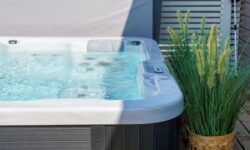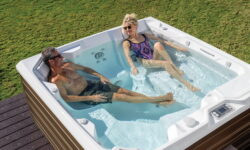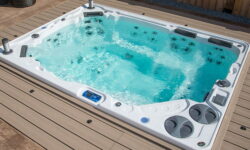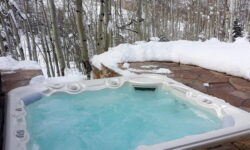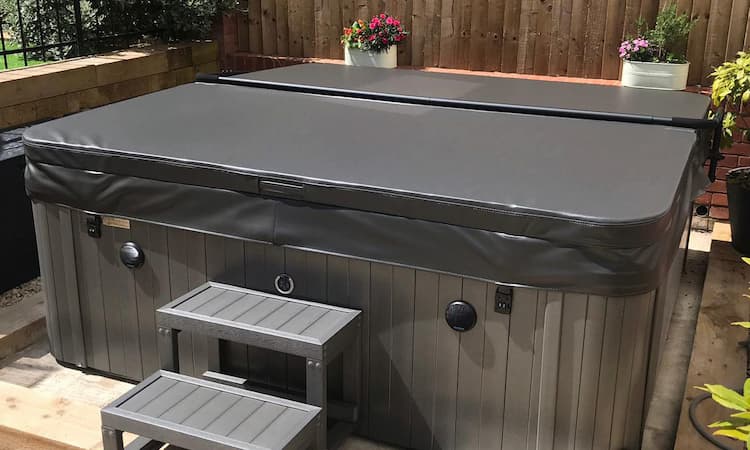You’ve always thought of a hot tub as your warm, bubbly escape. But have you ever considered flipping the script?
Yes, your hot tub can be cold. It’s not just possible, but it may also have unique health benefits. However, it defeats the purpose of the tub. Hot tubs are designed to provide a warm and relaxing soak, helping to soothe muscles and promote relaxation. If the water is cold, it won’t provide these benefits.
If you’re still intrigued by the idea of a chilly soak, let’s guide you through the science, benefits, transition process, and safety measures of using a cold hot tub. It’s time to dive into uncharted waters.
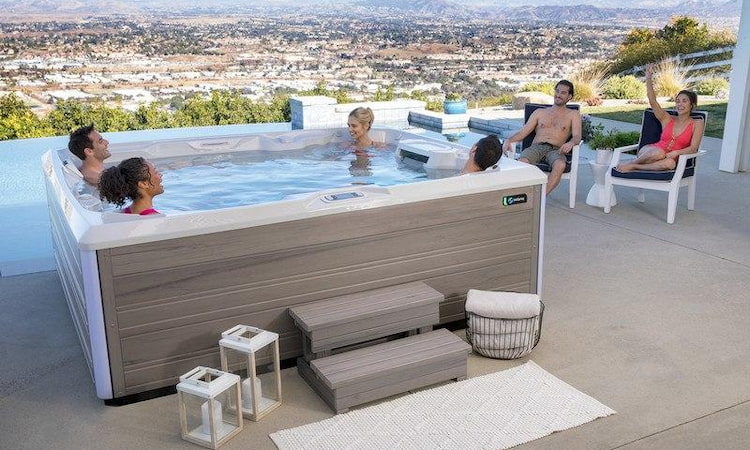
Quick Navigation
Understanding Hot Tub Temperature Settings
You’ve got to know that there are typically three temperature settings on a hot tub you can adjust. These settings are essential for maintaining hot tub efficiency and ensuring a comfortable soak. Here are some temperature control tips to help you get the most out of your hot tub experience.
Firstly, the standard range for a hot tub is between 100 to 104 degrees Fahrenheit. This is the ‘comfort zone’ for most people. But remember, you can adjust this according to your personal preference.
Secondly, if you’re not using the hot tub, it’s wise to lower the temperature. This not only saves energy but also increases the lifespan of the heater.
Lastly, if you’re planning to use the hot tub regularly, keep the temperature consistent. Constantly changing the temperature can strain the heater and reduce its efficiency.
The Science Behind a Cold Hot Tub
When you turn down the heat in your hot tub, you’re not just making it colder, but you’re also impacting the way the water molecules behave and interact. This change in temperature can kickstart Cold Resistance Development in your body, a crucial process that helps humans adapt to colder climates.
Here’s a breakdown of what happens:
- Cold resistance development: your body begins to increase its metabolic rate, producing more heat internally. Your blood vessels constrict, reducing heat loss to the environment.
- Therapeutic Hypothermia: it’s a medical practice where your body’s temperature is intentionally reduced. It’s used to help reduce the risk of tissue injury following periods of insufficient blood flow.
Potential Health Benefits of a Cold Hot Tub
Dipping into a cold hot tub, you’re not just bracing against a chill, but potentially unlocking a host of health benefits. Cold therapy benefits aren’t just limited to athletes, they’re for anyone brave enough to take the plunge. You’re likely curious about these advantages, so let’s break them down.
| Benefit | Description | Important Fact |
|---|---|---|
| Immune System Boost | Cold exposure can increase white blood cell count. | These cells protect against diseases. |
| Increased Metabolism | The cold can kickstart your metabolism. | This can aid in weight loss. |
| Muscle Recovery | Cold therapy can reduce muscle inflammation. | It’s why athletes often use ice baths. |
Cold therapy isn’t a new concept; it’s used by many for an immune system boost or quick muscle recovery. It’s also becoming popular for its potential to increase metabolism and thus assist with weight loss.
So, the next time you consider a hot tub, don’t just think about it as a warm, relaxing bath. Instead, see it as a potential health-boosting cold plunge. The cold hot tub isn’t for everyone, but for those willing, it offers intriguing health benefits.
Transitioning Your Hot Tub to a Cold One
In the process of transitioning your hot tub to a cold one, you’ll need to consider several factors to ensure an effective changeover. This includes re-evaluating your current maintenance habits, understanding the new requirements for cold tub maintenance, and considering eco-friendly considerations.
Cold Tub Maintenance
You’ll need to adjust your cleaning regimen. An essential part of this includes frequent water changes and the use of chlorine to prevent bacteria growth.
Another crucial aspect is the temperature control. Unlike a hot tub, a cold one needs to maintain a consistent low temperature, which can be a challenge during the warmer months.
Eco-friendly Considerations
Transitioning to a cold tub presents an opportunity to reduce your energy consumption significantly. This is not just good for your wallet but also for the planet. It’s also worth exploring sustainable cleaning products. These are not only better for the environment but can also extend the lifespan of your tub.
Safety Measures for Using a Cold Hot Tub
You’ll need to follow at least five key safety measures when using a cold hot tub to ensure a safe and enjoyable experience.
Firstly, use a high-quality cover to maintain the temperature of the tub. It not only conserves energy but also protects your tub from winter elements. Secondly, regular cold tub maintenance is vital. Ensure the water is treated and circulated to avoid freezing and damage to the tub’s components.
Thirdly, always check the temperature before stepping in. Hypothermia is a serious risk if the water is too cold. Fourthly, be cautious when getting in and out of the tub. The surrounding area can become slippery due to condensation or ice formation.
Lastly, limit your time in the tub. Extended exposure to cold water, especially during winter, can lead to health issues such as cold shock, hypothermia, and frostbite.
Following these winter usage tips will help you enjoy your cold hot tub safely. Remember, the key is to be mindful of your body’s reaction to the cold, keep the tub well-maintained, and adhere to safety protocols. This way, you’ll have a refreshing and revitalizing experience, even in the coldest of seasons.
Frequently Asked Questions
Converting your hot tub into a cold one may not be pricey. The cost primarily depends on your tub’s energy consumption and the complexity of the cold tub installation. It’s best to get a professional estimate.
Yes, you can frequently switch between hot and cold settings in your tub. However, such temperature transitions require careful tub maintenance to prevent damage and to ensure your tub’s longevity and functionality.
Yes, the usage of chemicals changes when your hot tub is used as a cold tub. Different chemical types for cold tubs are required and the cold tub maintenance process varies from a hot tub.
You can use a cold tub all year round. Cold tub maintenance doesn’t necessarily change with the seasons. Additionally, each season offers unique benefits for cold tub use, making it a versatile option.
Constant use as a cold tub can affect your hot tub’s lifespan. Regular cold tub maintenance and proper winterizing cold tubs can help prevent damage and extend the life of your hot tub.
Conclusion
So, can a hot tub be cold? Absolutely! With a proper understanding of temperature settings, you can easily transition your hot tub to a cold one. Not only does it offer potential health benefits, but it also adds a refreshing twist to your spa experience.
Just remember to adhere to safety guidelines to make the most of your cold hot tub. Now, go ahead and take the plunge into your new, cool oasis.

